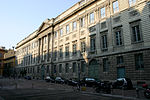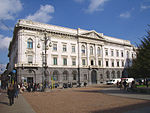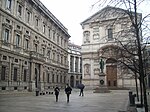Casa Manzoni

Casa Manzoni (in English Manzoni House) is a historical palace sited in via Morone 1 near the quadrilateral of fashion in the center of Milan, Italy. Owned by the Manzoni family, the house was the birthplace of the famous Italian writer Alessandro Manzoni in 1785.The building is also the venue of a museum dedicated to the poet life, the National Center for Manzonian Studies and the Historical Lombard Society (that has collected over 40,000 volumes about the history of Lombardy). Built in the 18th century, the palace was restored in 1864 by Andrea Boni in Renaissance Revival style, which especially characterizes the façade overlooking Belgiojoso square, designed in 1864 at the request of Manzoni by architect Andrea Boni and covered with red terracotta. The palace has hosted the gatherings of the club Il Conciliatore; famous men such as Giuseppe Verdi, Cavour and Garibaldi have visited it. On the ground floor, there's the seat of the Historical Lombard Society, a specialized library with a collection of over 40,000 volumes, and the National Center for Manzonian Studies. The Manzoni Museum is located in two rooms overlooking the garden on the ground floor and in six rooms on the first floor: the original furnishing and ornaments have all been entirely preserved.
Excerpt from the Wikipedia article Casa Manzoni (License: CC BY-SA 3.0, Authors, Images).Casa Manzoni
Via Gerolamo Morone, Milan Municipio 1
Geographical coordinates (GPS) Address Phone number Website External links Nearby Places Show on map
Geographical coordinates (GPS)
| Latitude | Longitude |
|---|---|
| N 45.4679 ° | E 9.1921 ° |
Address
Casa Manzoni
Via Gerolamo Morone 1
20121 Milan, Municipio 1
Lombardy, Italy
Open on Google Maps









